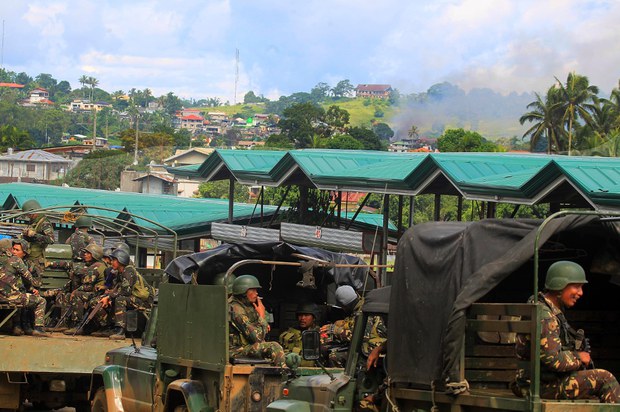Scores of Civilian Bodies Seen in Marawi: Philippine Official
2017.06.15
Marawi, Philippines
 Military reinforcements arrive in the southern Philippine city of Marawi, where government forces have been battling IS-linked militants for weeks, June 12, 2017.
Military reinforcements arrive in the southern Philippine city of Marawi, where government forces have been battling IS-linked militants for weeks, June 12, 2017.
As Philippine authorities announced the capture on Thursday of a suspected bomber for an Islamic State-linked (IS) group battling government forces in Marawi, a local official said witnesses had reported seeing scores of bodies strewn in the city’s streets.
Some residents were believed to be trapped in areas controlled by IS-affiliated militants in the southern Philippine city, while corpses of civilians who may have died of hunger or execution by gunmen were seen by people fleeing to safety, said Zia Alonto Adiong, the spokesman for the provincial government’s crisis management committee.
“Based on personal accounts of trapped residents who managed to cross the bridge from the encounter area to safety, there are roughly around a hundred bodies scattered on the streets and in advanced state of decomposition,” Adiong told BenarNews.
However, he said the report was being verified by rescuers and the military, which has not confirmed the figure. On Wednesday, Adiong had warned in an interview with Agence France-Presse that the local crisis management committee was “expecting the worst,” saying he and others feared that rescuers might find bodies of residents who had starved to death because food and water supplies had run out in the city. Battles between Abu Sayyaf Group and Maute gang militants, who have been backed by foreign fighters, have raged for more than three weeks.
‘A trained bomber’
On Thursday, Philippine authorities said they had arrested a suspected bomber for the Maute gang, who is believed to be a cousin of two brothers who have been leading the group in the fighting in Marawi. The suspect, identified as Mohammad Noaim Maute (also known as Abu Jadid) , was picked up at a rented house in Cagayan de Oro, a city about 70 km (43 miles) north of Marawi.
“He is a trained bomber who came here (Cagayan de Oro city). We are still trying to make him reveal his target but we presume that he wants to create destruction in some areas in Cagayan de Oro,” Chief Superintendent Agripino Javier, the Region 10 police director, told ABS-CBN, a local TV news channel.
Abu Jadid was arrested on a tip from a resident who recognized him from a list of wanted personalities in connection with the sacking of Marawi, portions of which are still under the control of the IS-linked gunmen, authorities said. The suspect is an Arabic studies teacher in Marawi and a suspected bomb expert for the Maute group, according to police.
The Philippine government earlier offered a bounty of 5 million pesos (U.S. $101,250) each for the capture of Abdullah and Omar Maute, the brothers who head the gang named after them. Their parents, father Cayamora and mother Farhana, were earlier arrested and held separately.
In a statement, the military expressed “its appreciation to the support of the people, for the information they gave that led to the arrest of Mohammad Maute.”
It said it was expecting more militants to be arrested in the coming days as the military intensified its campaign to end the crisis, which erupted on May 23.
As of Thursday, its tally placed the total number of those who have died in 24 days of fighting at 206 gunmen, 58 soldiers and policemen and 26 civilians.
Violence was triggered when troops and police moved to arrest Abu Sayyaf leader Isnilon Hapilon, the acknowledged IS chief in Southeast Asia.
But the authorities were surprised to discover a rebel contingent, with the Maute brothers bringing in fighters that included Malaysian, Indonesian and Singaporean militants.
Fierce clashes erupted, with the gunmen spreading around town and executing Christians in the predominantly Muslim city, according to military officials. The militants have also been holding dozens of hostages as “human shields,” including a Catholic priest, Philippine authorities said.
Military spokesman Lt. Col. Joar Herrera said the siege appeared to have been planned by the militants during the past three years.
“These are not ordinary militants and terrorists. They are ready to die for their ideology. They are very prepared. They have assorted high powered firearms and they are still capable of inflicting damage, but in due time we can liberate Marawi City,” Herrera said.
The official said the military intended to finish battles as soon as possible. Tactical commanders are getting vital help from U.S. special forces through technical and intelligence support.
“There are still snipers [positioned]. We continue to access the battle ground. It’s very fluid and dynamic so we have to re-access and strategize our options,” he said.
Herrera said anywhere between 200 and 500 civilians were still trapped inside the battle zones, which are concentrated in four villages in the heart of Marawi’s commercial district.
“We are receiving calls from the ground and we continuously communicate with them,” he said.
The situation on the ground has become extremely volatile, even for the press contingent documenting the war.
On Thursday, an Australian television journalist was evacuated after he was hit by a wayward bullet in the neck. The man, identified as Adam Harvey, is said to be out of danger.







